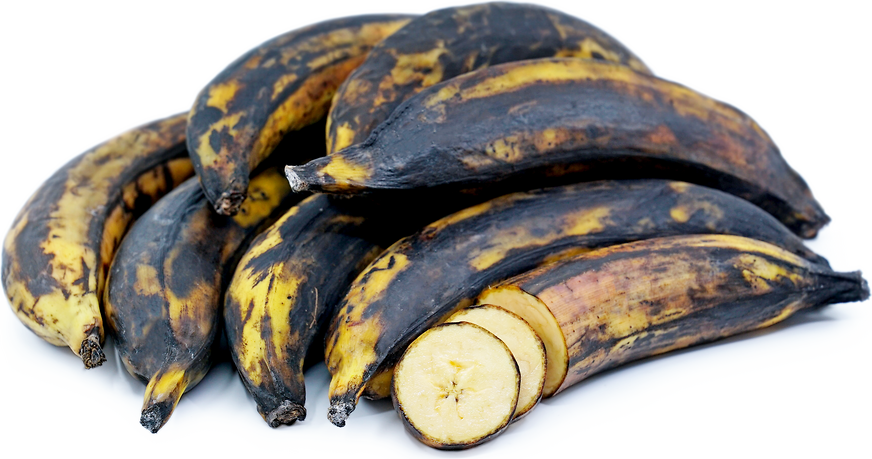


Black Plantain Bananas
Estimated Inventory, 40 lbs : -0.03
This item was last sold on : 07/13/25
Description/Taste
Black plantains are defined as plantains at their latest stage of maturity. They have an elongated banana-like crescent shape, that’s thickest in the middle and tapers to a tip at both ends. They measure around 15 to 38 centimeters long and have mostly black skin with bright yellow sections peaking out underneath, resembling an overripe banana. Their splotchy yellow and black appearance gives the fruit a bruised look despite them being completely edible. Black plantains have three ridges that run along their length, and their skin is smooth, thick, and relatively matte in complexion. The skin remains firm throughout their ripening process but attains a slightly softer feel once they turn black. Plantains have light yellow flesh that’s initially firm and starchy but becomes creamier and softer as it matures. This fruit has a sticky texture and strong aromas of vanilla and banana. Their flesh goes from savory to mildly sweet when their skin reaches this black hue. The flavor of Black plantains contains notes of sweet potato and banana.
Seasons/Availability
Plantains are available year-round.
Current Facts
The botanical name for Black plantains is Musa paradisiaca and they are from Musaceae family. They are often compared to bananas though they are longer, straighter, and less sweet. Plantains transition from green to yellow then black, the latter being the fruit in its ripest and most sweet state. Plantains have been a culinary staple for centuries and are the tenth-most essential food internationally. They originated from Southeast Asia but are closely associated with Caribbean and Latin American cuisine, where they are used as a neutral base for many national dishes. There are many different varieties of this fruit including Horn, French, Dominican, and African Plantains, all of which turn black at their ripest point.
Nutritional Value
Black plantains contain vitamins A, C, and B6, which can benefit the immune system, vision, cell growth, collagen production, iron absorption, metabolism, and brain and reproductive health. This fruit provides the body with fiber to improve digestion, increase fullness, and help with cholesterol management. Black plantains are also a source of magnesium, a nutrient that assists with bone and heart health, calcium absorption, blood sugar control, nerve and muscle function, energy production, mood regulation, migraine prevention, and inflammation reduction. They are high in potassium, which maintains body fluids, heart rate, blood pressure, and may aid in reducing cholesterol.
Applications
Black plantains can be eaten raw, fried, boiled, baked, puréed, or sautéed. In their raw form, they can be diced into fruit salad, ceviche, smoothies, and wraps with lettuce, hummus, grilled vegetables, and avocados. Black plantains are usually too soft and sweet to be cooked into plantain chips or tostones, but they can be sliced up and fried to create a sweet, caramelized texture. They may be baked whole, mashed up for plantain bread or pancakes, or incorporated into a plantain lasagna called Pastelón. Black plantains are a popular food in Latin and Caribbean cuisines where they are used in dishes like maduros, bolón de verde, mofongo, rondón, and plantain empanadas. They enhance the flavor and depth of other ingredients such as chicken, beans, pork, and seafood. Complimentary pairings include mangoes, red onions, chili peppers, limes, strawberries, pineapple, brown sugar, mellow cheeses, coconut, and spices such as cumin, curry, turmeric, and cilantro.
Ethnic/Cultural Info
Plantains produce fruit without pollination, a sensation that is explained by a legend of the Gadaba people of Eastern India, an area where plantains are cultivated. They believed that long ago, there were five crop sisters: Mango, Fig, Jamun, Tamarind, and Plantain. When these sisters came of age, their father was concerned about them producing too many children. He asked Plantain about her life goals and in response, she said she wanted to have children soon but didn’t want to have to wait to find a husband. While all the other sisters were eventually married and bore so many offspring that their overwhelmed husbands fleed, Plantain had children without marrying. This legend is thus continued today by Plantains cultivating many fruit without having to bear seeds or be pollinated.
Geography/History
Plantains are native to tropical Southeast Asia, particularly Malaysia and Indonesia, and can be traced back to 500 BCE. They were brought to Africa through Trans-Saharan trade routes and made their way to the Caribbean during the time of Spanish and Portuguese colonization when a Franciscan Monk introduced them to Santo Domingo island in the early 1500s. Plantains were also brought to the region during the time of the African slave trade. These fruits flourish in tropical and subtropical climates and may be found growing in the Southeast Asian rainforests, lowland forests, riverbanks, wetlands, and foothills. They are most often cultivated on farms and in gardens. Plantains remain popular in Spain, Portugal, Mexico, Japan, Malaysia, India, Egypt, Ghana, Nigeria, Brazil, and some parts of the United States. Black plantains are not often sold in this ripened state at stores. They may be purchased when they are green or yellow from Asian or Latin markets and can then be ripened to their black color a few days later.
Featured Restaurants
Restaurants currently purchasing this product as an ingredient for their menu.
| Camino Riviera | San Diego CA | 619-685-3881 |
| Tahona (Kitchen) | San Diego CA | 619-573-0289 |
| Hotel Republic San Diego | San Diego CA | 951-756-9357 |
| Sugar Bear Enterprises | San Diego CA | 925-383-3623 |
| Carte Hotel | San Diego CA | 619-365-1858 |
| Pizzeria Luigi | San Diego CA | 610-539-7025 |
Recipe Ideas
Recipes that include Black Plantain Bananas. One
| Cadry's Kitchen |
|
Plantain & Black Bean Burritos |
Podcast

















